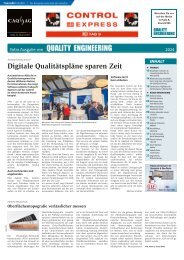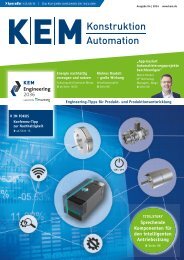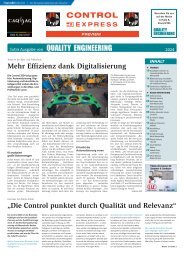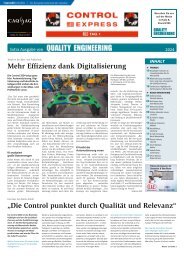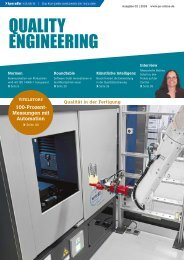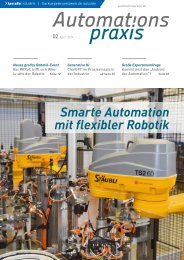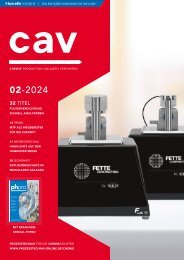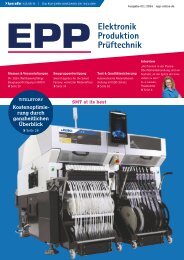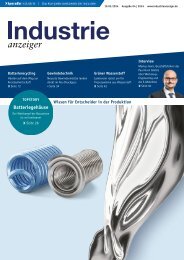EPP Europe P2.2022
Create successful ePaper yourself
Turn your PDF publications into a flip-book with our unique Google optimized e-Paper software.
» PCB & ASSEMBLY<br />
FOUPs and other storage facilities should<br />
be cleaned to prevent cross-contamination<br />
of the wafers<br />
Source: Microcare<br />
of the hydrofluoro-olefin fluids results in<br />
greater drag forces acting on the particles.<br />
This makes it easier to dislodge the<br />
particulate from the substrate. The particles<br />
push away from the substrate and<br />
wash away, dispersing into the cleaning<br />
fluid.<br />
Low boiling point<br />
Particle displacement fluids are lowboiling<br />
with typical boiling points between<br />
40˚C/105˚F and 65°C/165°F. This<br />
minimizes the risk of damage to wafers<br />
and other delicate components. Vaporization<br />
displacement fluids (below 100°C)<br />
are aggressive enough to remove the particles,<br />
yet won’t damage the substrate,<br />
including composite materials. They are<br />
compatible with most hard plastics, ceramic,<br />
glass and metal.<br />
Low boiling fluids also allow the vapor<br />
degreaser to run more efficiently. And<br />
since vapor degreasing cleans and dries in<br />
one step, there is no need for blowers, air<br />
knives or any other drying method that<br />
uses power. This translates into less fossil<br />
fuel consumption, lower carbon emission<br />
and reduced greenhouse gas output. All<br />
with the added benefit of energy cost<br />
savings.<br />
Environmentally friendly<br />
Environmentally-friendly HFO-based<br />
displacement fluids replace higher GWP<br />
(Global Warming Potential) hydrofluorocarbon<br />
(HFC) and hydrofluoroethers<br />
(HFE)-based fluids. They also are better<br />
for the environment than high ODP<br />
(Ozone Depleting Potential) solvents like<br />
CFC-113, HCFC-141b, HFC-225 and 1,1,1<br />
trichloroethane. They meet strict regional<br />
air quality regulations and many are not<br />
considered HAPs (Hazardous Air Pollutants).<br />
Many fluids are accepted by key<br />
environmental and governmental regulatory<br />
agencies in the United States and<br />
most countries around the globe. They<br />
meet global environmental directives including<br />
the <strong>Europe</strong>an F-Gas and REACH<br />
(Registration, Evaluation, Authorisation<br />
and Restriction of Chemicals) legislation.<br />
Environmentally sustainable<br />
Vapor degreasing with particle displacement<br />
fluids uses no water, conserving<br />
this precious non-renewable resource.<br />
In addition, the process doesn’t produce<br />
wastewater that requires specialty filtration<br />
or treatments before disposal.<br />
Another environmental benefit of particle<br />
displacement through vapor degreasing<br />
is its suitability for recycling. The<br />
displacement fluid is used for hundreds of<br />
cycles before it requires refreshing or replacing.<br />
Additionally, the vapor degreaser<br />
concentrates the contaminants as it<br />
works. This reduces waste generation and<br />
lowers hazardous waste disposal costs.<br />
Wrapping up<br />
Particle contamination is detrimental<br />
to intricate semiconductors and silicon<br />
wafers. Removing contamination is essential<br />
to ensuring their performance.<br />
Vapor degreasing using particle displacement<br />
fluid not only ensures semiconductor<br />
cleanliness, it also addresses environmental<br />
and regulatory concerns.<br />
Companies looking for help with displacement<br />
cleaning should partner with<br />
an expert that has displacement fluid and<br />
vapor degreasing expertise. They can conduct<br />
on-site audits or perform in-lab<br />
tests with sample wafers to ensure cleaning<br />
success. Based on the wafer substrate<br />
and the particulate, these specialists can<br />
recommend, or engineer, the fluids and<br />
processes that achieve the best results.<br />
www.microcare.com<br />
Zusammenfassung<br />
Die Entfernung von Verunreinigungen bei komplexen Halbleitern<br />
und Silizium-Wafern ist durch Dampfentfettung mit Partikelverdrängungsflüssigkeit<br />
gewährleistet und berücksichtigt zudem Umweltaspekte<br />
sowie gesetzliche Vorgaben.<br />
Résumé<br />
L'élimination des impuretés dans le cas de semi-conducteurs complexes<br />
et de plaquettes de silicium est assurée par un dégraissage à<br />
la vapeur avec un liquide de déplacement des particules. Elle tient<br />
également compte des aspects environnementaux et des exigences<br />
légales.<br />
Резюме<br />
Удаление загрязнений в случае сложных полупроводников и<br />
кремниевых пластин осуществляется методом паровой<br />
очистки с использованием вытесняющей жидкости, при этом<br />
учитываются аспекты охраны окружающей среды и<br />
требования законодательства.<br />
24 <strong>EPP</strong> <strong>Europe</strong> » 11 | 2022



